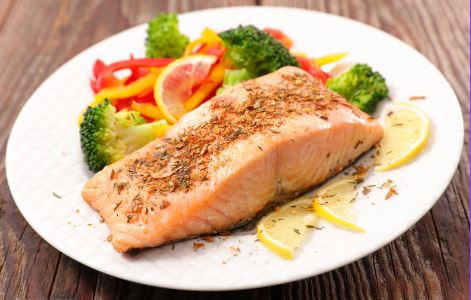
- ✓ Quite possibly the healthiest food on the planet!!
- ✓ Wild caught in Alaska's pure & pristine Bering Sea.
- ✓ Follows strict sustainability protocols.
- ✓ Flash-frozen & processed in AK (100% USA).
- ✓ Perfect for grilled, baked or smoked salmon.
- ✓ Caught by a WI commercial fisherman.
1, 1 1/2 lb filet of boneless, skin-on Sockeye Salmon, sustainably-caught in Alaska's Dutch Harbor, flash frozen and vacuum-sealed.
According to Mark the fisherman and owner of Bering Bounty who lives in Wisconsin(!), Sockeye is his target fish. Why? Because he says it's the best fish for you on the entire PLANET. 🌎
The science seems to agree with him. Check this out. Wild Alaskan Sockeye salmon contains:
- the highest amount of Vitamin D of any fish at 24 micrograms or 120% RDI for a 6oz serving
- lower fat content (so be a bit careful cooking)
- cooked, 3 oz = 23g of complete proteins, 5g fat, 730mg Omega-3s, 3.8mcg Vitamin B12, 50mcg Vit A, 14.2mcg Vit D, selenium, potassium, iron, copper, zinc and so much more! And it's bioavailable!
Flavor. Sockeye has bold salmon flavor with a tender but meaty bite. One of the most flavorful of the salmons. Firm texture holds up to grilling, smoking or sushi.
Appearance. You are what you eat! And Sockeyes eat lots of krill, plankton, shrimp and small crustaceans while in the ocean, which are full of the carotenoid antioxidant astaxanthin....which turns the fish pink (same thing happens to flamingos!).
Sockeye also refuses to be raised in captivity (good for them I say!) so if you trust the label when it says "Sockeye" you know it was not farmed or raised in captivity.
Recipes!
It's so easy and so fast to cook, but did you know it gets even faster and easier if you use Captain Mark's directions of cooking from frozen?! Check 'em out:
Eat the skin!!
But only if it's wild fish. The skin of farmed or contaminated fish is basically a biohazard of mercury, PCBs and more. However, the wild ones store all the good stuff there!
"Just like the flesh, salmon skin is a good source of omega-3 fatty acids, vitamins B and D, and minerals like niacin and phosphorus. Not only is it a good source of omega-3s, but it’s actually where the highest concentration of these hard-to-get fatty acids are found!
Not only does leaving the skin on treat your mouth to a unique flavor and texture, but the additional omega-3s may minimize inflammation, support brain development, and reduce your triglyceride levels, therefore your risk of heart disease.
And the good news keeps getting better. By keeping the skin on during cooking, it also helps to retain salmon’s many nutrients and healthy oils. You’ll end up with a tastier meal with more nutrients because they won’t be lost during the preparation process." See more info here.
If you refuse to eat it, please, at least, feed it to your dog.
Fun facts:
- Sockeyes are smaller than Kings or Cohos at just 4-6lbs.
- They are also referred to as Reds because of their vibrant color.
- While slightly more abundant than Kings, they are still a highly exclusive fish.
- Lives in freshwater for 1-3 years, then feeds in the ocean for 2-3 years before returning back to their freshwater origin and spawning (freshwater and saltwater fish are "anadromous"), they then die after a few weeks of spawning infusing the rivers with extraordinary fertilizer, starting the cycle of life over again.
- The female lays 2-5,000 eggs!
- They find their way home via smell.
- Over their lifetime most will travel thousands of miles and some climb thousands of feet in elevation.
Sad facts:
- 90% of the seafood consumed in the US is imported (mostly from China and Russia). With most of the salmon coming from fish factories in Norway and Chile.
- Most grocery store salmon is processed overseas and re-imported through a long supply chain of middlemen.
- Typically 7-10 middlemen are used to get fish from water to shelf.
- Farmed salmon.
- Raised in a "fish factory" or CAFO (Confined Animal Feeding Operation) in cages full of parasites and diseases (b/c the fish are so unhappy they are trying to die).
- Eat GMO soy & corn, meat by-products like chicken feathers, canola meal and dye. Note the high soy composition in their feed means goodbye healthy omega-3s and hello inflammatory disease-causing omega-6s!
- doused regularly with pesticides and antibiotics (sea lice, eww) but still have a staggering death rate of 15-20%.
Seafood Watch, an independent guide to fish consumption affiliated with the Monterey Bay Aquarium, recommends avoiding most farmed Atlantic salmon because of excessive chemical use and disease. Read more HERE.


Why should bears have all the fun??






